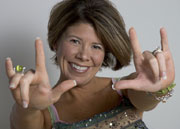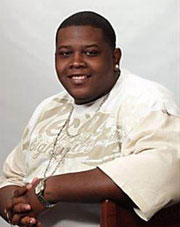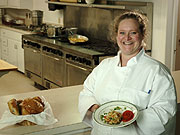REDMOND, Wash., Nov. 10, 2005 —A tool for tracking drag car racing performance. A nonprofit to tackle the problem of food insecurity. A Web site to promote awareness of cochlear implants for the deaf. A sketch comedy TV show. And a music production and engineering studio, all on a computer.
These are highlights from the five winning projects in the Start Something Amazing Awards – a Microsoft-sponsored nationwide program honoring people who use Microsoft Windows and related technology in simple yet powerful ways to pursue the things that they are passionate about. The awards were given in five categories: Culture and Community, Music, Memories, Home and Lifestyle, and Sports and Games. The winners are:
-
Culture and Community: Michelle Tjelmeland, Springfield, Ill. After becoming deaf at age 22 and giving birth to a deaf child shortly thereafter, Tjelmeland had to give up her job as a teacher and used Microsoft technologies to help build a new life. She earned a masters degree online and then started her own Web development business. She also donates Web sites to nonprofits to assist them in promoting their causes, and has created Web sites to raise awareness of cochlear implants and to share her experiences with deafness as an individual and a mother.
-
Music: Andre Isom, Benton Harbor, Mich. Isom is realizing his dreams of being a music producer, artist and engineer via a Microsoft-based studio that he has set up at his home. He uses Windows XP and programs such as Propellerhead Reason, Steinberg Nuendo and Wavelab to produce several local R&B, hip-hop and gospel artists and help them pursue their musical dreams.
-
Memories: E.J. Dyksen, Grand Rapids, Mich. With the help of friends from his improv troupe and Microsoft technologies, Dyksen created “LaughterHouse Five,” a sketch-comedy TV show. Under Dyksen’s direction, the group has already shot a pilot sketch and has plans to distribute future sketches digitally.
-
Home and Lifestyle: Diane Reeder, Kingston, NY. Reeder created The Queens Galley – a nonprofit group that recruits volunteer chefs to tackle the issue of food insecurity by teaching seniors, women in domestic violence shelters and families in need how to stretch their food supplies. Microsoft technologies have played a key role in the group’s Web site and other publications, including a planned collection of recipes called the Stone Soup project.
-
Sports and Games: Jeannine Johnson, Puyallup, Wash. Microsoft technologies have enabled this drag-racing teen to take her game to the next level. Johnson’s PC enables her to tune her car to ensure she’s on top of the latest conditions impacting it. Johnson connects her Windows-based PC to her car’s Data Acquisition System that measures engine RPM, jack shaft speed and motor temperature variances from start-to-finish during each race. She also uses Microsoft Word and Microsoft PowerPoint to help maintain a 3.8 GPA and retain her racing sponsorships.

Michelle Tjelmeland
The award winners are in Seattle this week, and will have the opportunity to meet Microsoft Chairman and Chief Software Architect Bill Gates. They also receive US$5,000 in Windows technology and other once-in-a-lifetime prizes designed to further celebrate their passions ranging from a National Geographic expedition to Bhutan to VIP access to a Live@VH1 concert. One grand prize-winner also will be featured as part of the national Start Something ad campaign in the U.S.
To learn more about the award recipients and their hobbies, PressPass spoke with the five winners.
PressPass: How did you hear about the Start Something Amazing Awards and why did you enter?
Reeder: An ad popped up with the words “Start something culinary.” It was a picture of a chef holding a whisk, and then the Microsoft logo. I had to go see what it was about. I thought to myself, “OK, I started something culinary with our Queens
Galley Web site (http://www.queensgalley.org/). Let’s see if somebody else thinks it’s amazing, other than my mother or the people that we work with.”

Andre Isom
Isom: I ran across the Start Something Amazing Awards information one night on Microsoft.com and saw there was a category for music and I said, “What do I have to lose?” I live in a small town and I’m trying to get out there as an artist and a producer, so if there’s anything I can do to help myself, then by all means I’m going to do it.
PressPass: How do you use Microsoft technologies in what you’re passionate about?
Johnson: I’ve been racing dragsters since I was 9 years old and have done very well, but this year my team made a big breakthrough with the help of Microsoft technologies. Using Windows XP and wireless network capabilities, we have been able to take a computer with us to each event, which allows us to download information from my car’s computer to the computer in our trailer; there’s a data acquisition system on my car that hooks up to the computer and helps me keep tabs on the car’s vital signs. In racing Junior Dragsters, the special software we use – called Crew Chief Pro – runs on coding that can only be read with Windows. The Crew Chief Pro program feeds us data about the weather and the car’s performance with RPMs, jack-shaft speed, and the temperature of the motor at launch, during my run and at the finish line. With this capability, we’ve seen great improvements with the car because we’re able to get so much more data.

E.J. Dyksen
Dyksen: As the creator and producer of the “LaughterHouse Five” show, it is my job to keep track of everything. I use Microsoft Windows XP Tablet PC Edition with Microsoft Office OneNote to keep track of ideas for shows and take notes at meetings. We use Microsoft Windows 2003 Server to communicate through a message board, setting up times and pitching script ideas. I have a Microsoft Windows XP Media Center PC that I built before coming to college, and it’s great for video editing. If we have meetings, I sometimes do a little PowerPoint presentation off of the Tablet PC.
Isom: I have my own studio and another guy and I are trying to work on our own albums, but we also do a lot of promotional music around here in the city for different radio stations. During the week, it’s hip-hop, R&B, jazz, blues and a lot of old songs, and I have a gospel show on Sunday morning called “BiGg DrE’z Inspirations.” We work from a computer, whereas everybody else does live DJ or uses CDs. But I always find it better to load all my music in the computer, in the laptop, and then take it to the radio station, and use Windows Media Player and go from there. I like to do things the easy way, so why not do it on the computer and play what you want to play at the press of a button?
PressPass: What other technologies do you use and for what?

Diane Reeder
Reeder: A recent donation of Microsoft Publisher has allowed us to create a newsletter, member guide and workshop publications. We’ve also used Microsoft Front Page for the design of our Web site. I’m not a computer person, but Front Page is so easy – I know that I have this box here, and I push some buttons, and it does what I need it to do. MapPoint has also proven invaluable for getting to those unknown locations for our workshops, and we would all be lost without Office XP. We’ve even used Microsoft Publisher to design images to use on icing for cookies. You can buy cornstarch sheets that you can actually feed through a printer and use food coloring for ink!
Isom: I use Propellerhead Reason, Steinberg Nuendo and Wavelab. The thing I like about Windows XP is that it makes my computer more user friendly, with all the different types of audio cards and plug-and-play devices I have. Windows XP is like my best friend. I use Windows Media Player for burning my CDs and creating different CDs.

Jeannine Johnson
Johnson: I was in a technology class and we had to make mini-movies. After we filmed the movie, we used Windows Movie Maker to go in and edit all of the effects and do a lot of cool stuff. My school also had a film festival and I did a movie about drag racing, and so I was able to edit the movie and make it presentable using Windows Movie Maker.
Tjelmeland: To connect with the deaf community as well as my family and clients, I use MSN Messenger, e-mail and online blackboards. I do most of my tech support for my Web site business through instant messaging (IM). My clients have my IM screen name so I never have to worry about missing something because of my hearing loss. They’ll tell me their problem through IM and Live Chat, we get on their Web site, and I walk them through the troubleshooting process.
Dyksen: I use Windows Media technologies mainly to encode the video to compress it because basically Windows Media is the easiest to use and it is available for free. These technologies work pretty well across all platforms.
PressPass: Some of you are involved in efforts that touch the broader community. Can you talk about that?
Tjelmeland: When I lost my hearing, and my daughter was born deaf, I went into severe depression. I knew I had to recreate my life because I could no longer hear. One of the things I did, which was like therapy to me, was to create a Web site, I Love Ellie (http://www.Iloveellie.com/) to help other individuals who were either going through what I had experienced, or who had a deaf family member or a deaf baby and were looking for options. More recently, I founded a nonprofit organization (Cochlear Implant Awareness Foundation, www.ciafonline.org) to provide financial assistance for people that want to get cochlear implants.
Reeder: Food insecurity sort of gets overlooked because, I feel, it’s the stepchild to the thousand-pound gorilla of hunger. We are a visual society, our compassion goes out to people, to things we can see or easily imagine. We can visualize homeless people standing in a soup line, huddled in a corner, cold. We have trouble, I think, having compassion for the family who’s overextended themselves because of credit-card debt and can’t afford to put nutritious food on the table. So by offering classes to families on how to choose affordable nutritious food, how to cook it, how to clean it, how to prepare it, how to store it, we’ve been able to help these people spend their food dollars more wisely. My theory is that if we can help solve food insecurity by teaching people to make the best of what they have access to, we may put a significant dent in that bigger problem of hunger.
PressPass: How do you hope to continue using technology to pursue your passions?
Isom: I’d like to stay abreast of all the new technology that comes out, because I don’t want to get left behind. I know if I have that knowledge, one day I’ll be able to help other musicians that don’t know about the new technology. It’s a great help for me now, and I know it will be in the future as well.
Tjelmeland: One of the biggest things that I think is important in my field is that I constantly have to stay aware of what’s new and what’s out there because technology changes so fast. So researching the programs that are out there is something that I constantly do. Everything I do involves technology — from using my cell phone with text messages to being able to hear because of the computer chip inside my head to using my digital camera on a daily basis. So if you took technology away from me, you’d probably have to lock me up in a room because it’s my lifeline.




